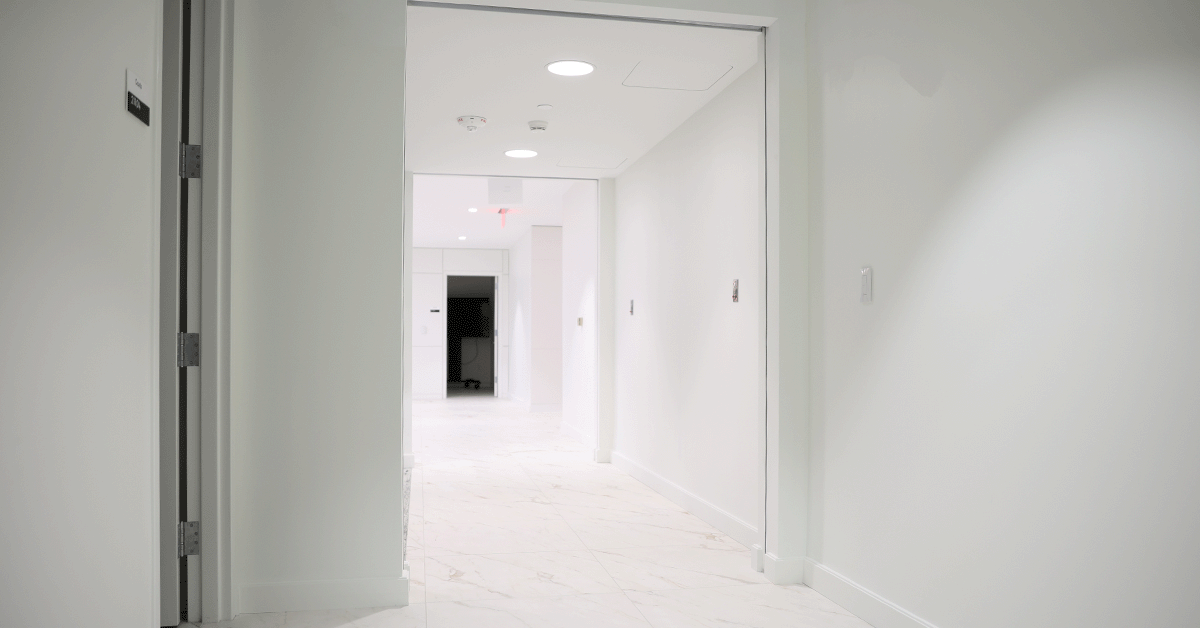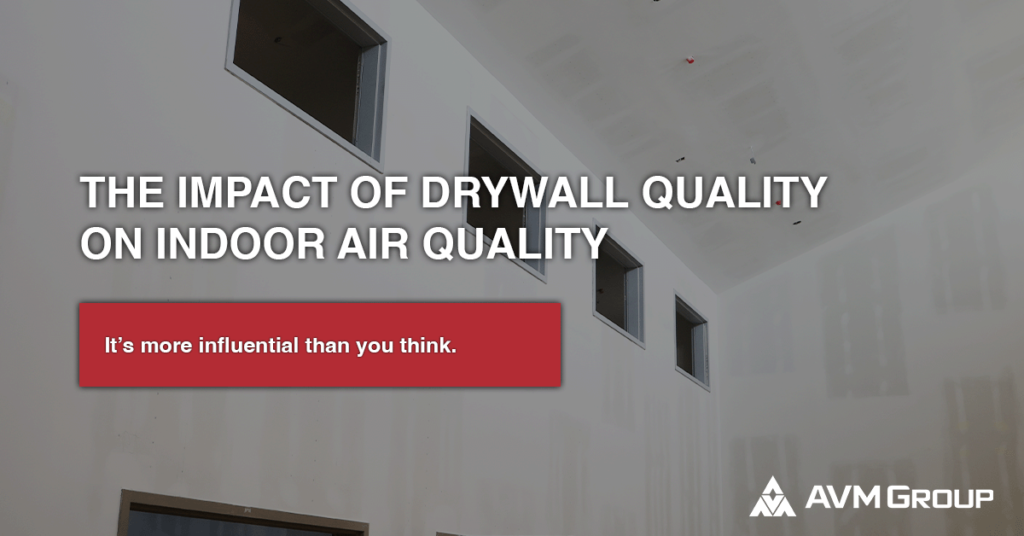*This post is part of a much larger pillar blog: The Complete Commercial Drywall Guide
Table of Contents
ToggleIntroduction
Indoor air quality (IAQ) is more critical than many of us realize.
With most people spending up to 90% of their time indoors, the air we breathe inside our homes and workplaces has a profound effect on our health and well-being.
But did you know that the materials used in your walls, particularly drywall, can significantly impact the air quality in your living spaces?
Yes, that seemingly benign aspect of your commercial building is more influential than you might think.
In this article, we’ll delve into how the quality of drywall can make or break the air quality in your commercial building environment.
As always, before we get into the bulk of this article, we’ll provide you with a quick overview of drywall, just to be safe.
Understanding Drywall
Drywall, also known as gypsum board, plasterboard, or sheetrock, is a staple in modern construction. It’s used to create walls and ceilings, providing a smooth surface that can be painted or wallpapered.
Drywall is primarily made from gypsum, a naturally occurring mineral, sandwiched between two sheets of heavy paper.
However, the quality of materials and the manufacturing process can vary significantly, which in turn can affect the performance of the drywall and its impact on air quality.
If you want more information on drywall, check out our article: the different types of commercial drywall.
Now that we have a solid baseline, let’s talk about the connection between drywall quality, and the indoor air quality of your commercial space.
The Link Between Drywall Quality and Air Quality
How does drywall quality relate to air quality?
The answer lies in the material’s ability to control moisture, resist mold, and avoid releasing harmful chemicals.
High-quality drywall is designed to minimize these risks, creating a safer and healthier indoor environment.
On the other hand, low-quality drywall may not effectively manage these factors, leading to poor indoor air quality because of reasons we’ll discuss in-depth in the sections below.
First up, off-gassing, an often overlooked threat.
Off-Gassing: The Hidden Threat
One of the lesser-known issues with drywall is off-gassing.
This occurs when volatile chemicals used in the manufacturing process are released into the air over time.
These chemicals, often referred to as volatile organic compounds (VOCs), can include formaldehyde, acetaldehyde, and benzene—substances that are harmful when inhaled.
Off-gassing can contribute to a range of health issues, from headaches and dizziness to more severe respiratory problems.
GET THE LATEST INDUSTRY NEWS DELIVERED TO YOUR INBOX
Stay on the forefront of the construction industry with our weekly e-newsletter.
The Role of Volatile Organic Compounds (VOCs)
VOCs are organic chemicals that easily vaporize at room temperature.
In drywall, they can be present in the gypsum core, the paper facing, or the adhesives used during installation.
The impact of VOCs on indoor air quality is significant, as they can linger in the air for years, contributing to indoor pollution.
Regulations have been put in place to limit the amount of VOCs in building materials, but not all drywall meets these standards, making it essential to choose products that are certified for low VOC emissions.
Moisture and Mold: The Consequences of Poor-Quality Drywall
Next up, moisture and mold. A much more well-known threat, moisture is the enemy of good air quality, and poor-quality drywall is often more susceptible to absorbing moisture.
When drywall becomes wet, it can quickly lead to mold growth—a major indoor air pollutant.
Mold spores released into the air can cause allergic reactions, asthma attacks, and other respiratory issues.
Opting for mold-resistant drywall is a proactive step in maintaining good indoor air quality.
We talk a lot about how moisture can negatively affect drywall in our article: The 3 Biggest Causes of Drywall Damage.
Fire-Resistant Drywall and Air Quality
Fire-resistant drywall, also known as Type X or Type C drywall, is another important factor in maintaining a safe indoor environment, especially in commercial buildings.
While its primary purpose is to slow the spread of fire, it also contributes to better air quality by reducing the amount of smoke and harmful particles released into the air during a fire.
High-quality fire-resistant drywall often contains additives that enhance its performance, making it a wise choice for both safety and air quality. Obviously, you would like to not worry about issues with fire, but it’s reassuring to know that you have drywall that can actively help your breathing and air quality out in a pinch!

Sustainable Drywall Options
Sustainability in construction is more than just a buzzword—it’s a necessity, especially when it comes to IAQ!
Sustainable drywall is often made from recycled materials and produced with fewer harmful chemicals, resulting in lower VOC emissions.
Look for certifications like GREENGUARD or LEED when choosing sustainable drywall products to ensure you’re making a choice that’s good for both your health and the planet.
If you’re working with an experienced commercial drywall contractor, they’ll make sure to build this into their plan for your building.
The Importance of Proper Installation
Even the highest quality drywall can fail to improve air quality if it’s not installed correctly.
We’ve talked about it extensively in our guide to proper drywall installation, but we’ll say it again!
Gaps, poor sealing, and incorrect handling can lead to issues like moisture intrusion and off-gassing.
Proper installation involves using the right techniques, materials, and tools to ensure the drywall performs as intended.
Hiring experienced professionals for drywall installation such as AVM Group is crucial to maintaining optimal indoor air quality.
Maintaining Drywall for Optimal Air Quality
Once installed, drywall requires regular maintenance to keep your indoor environment healthy.
This includes regular inspections for signs of moisture, mold, or damage done by your facilities management team.
Prompt repairs are essential to prevent small issues from escalating into significant air quality problems. Simple maintenance tasks like cleaning and repainting can also help prolong the life of your drywall and maintain good air quality.
If you have a serious issue with your commercial drywall, don’t try to fix it yourself. It’s much better to contact the company who installed it for you.
Cost vs. Quality: Is it Worth Investing in High-Quality Drywall?
When it comes to drywall, the old adage “you get what you pay for” often holds true.
While high-quality drywall may come with a higher upfront cost, the long-term benefits—better air quality, fewer repairs, and enhanced safety—often outweigh the initial investment.
On the other hand, opting for cheaper, lower-quality drywall can lead to higher costs down the road due to health issues, frequent repairs, and potential legal liabilities.
Conclusion
In conclusion, the quality of drywall in your workplace is more than just a structural concern—it’s a matter of health and well-being.
By choosing high-quality, sustainable drywall, ensuring proper installation, and maintaining your walls over time, you can significantly improve the air quality in your indoor spaces.
It’s an investment in your health and safety that’s well worth making.
Check out our blog to learn more about commercial drywall.
Need to install new commercial drywall, or repair/replace existing gypsum? Contact us.



